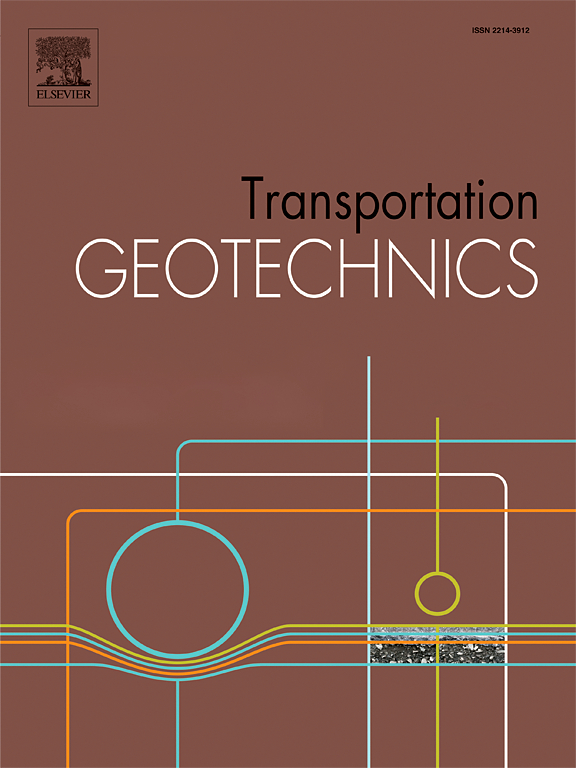Response of buried pipelines subjected to ground subsidence using a nonlinear Pasternak approach
IF 4.9
2区 工程技术
Q1 ENGINEERING, CIVIL
引用次数: 0
Abstract
Pipelines, vital for transporting resources, face significant structural challenges due to ground movement. Many studies have been conducted to examine the impact of ground subsidence on pipelines, each aiming to improve our understanding of soil-pipe interaction using various techniques. Commonly, Winkler or Pasternak models are adopted to account for the interaction between the pipeline and its supporting soil. However, these models fall short in addressing the inherent nonlinearity of the supporting soil, which may lead to considerable inaccuracies. To address these limitations, a nonlinear Pasternak model is developed in this research that is capable of capturing the nonlinearity of the soil supporting the pipelines. Besides, the settlement trough is appropriately modeled to consider the surface subsidence profile. The nonlinear soil behavior is modeled using a hyperbolic load-settlement relationship while the pipeline is represented by an Euler-Bernoulli beam. Validation of the model is carried out against centrifuge test data that confirm the model’s capability to accurately simulate displacements and bending moments along the pipe. A parametric study highlights that higher soil bearing capacity and initial subgrade reaction modulus lead to reduced deflection and internal forces in the pipeline. Additionally, the results indicate a threshold for the soil’s bearing capacity beyond which variation in the vertical displacements and bending moments is minimal. Also, an increase in the distance between the inflection point and maximum settlement of the subsidence profile results in higher pipeline deflection, bending moments, and shear forces. Furthermore, using Genetic Programming, empirical equations are derived that offer reliable estimates for the maximum vertical displacement, bending moment, and shear force, providing practical tools for pipeline design in subsidence-prone areas.
地表沉降作用下埋地管道的非线性帕斯捷尔纳克响应
由于地面的移动,对资源运输至关重要的管道面临着重大的结构挑战。已经进行了许多研究来检查地面沉降对管道的影响,每项研究都旨在利用各种技术提高我们对土-管相互作用的理解。通常采用Winkler或Pasternak模型来解释管道与其支撑土之间的相互作用。然而,这些模型在处理支撑土的固有非线性方面存在不足,这可能导致相当大的不准确性。为了解决这些限制,本研究开发了一个非线性帕斯捷尔纳克模型,该模型能够捕捉支撑管道的土壤的非线性。同时,考虑地表沉降剖面,对沉降槽进行了适当建模。土的非线性特性采用双曲荷载-沉降关系建模,管道采用欧拉-伯努利梁表示。利用离心机试验数据对模型进行了验证,证实了该模型能够准确地模拟沿管道的位移和弯矩。参数化研究表明,较高的土壤承载力和初始路基反力模量可以减小管道的挠度和内力。此外,结果表明了土壤承载力的阈值,超过该阈值,竖向位移和弯矩的变化最小。同时,随着沉降曲线拐点与最大沉降距离的增大,管道挠度、弯矩和剪力增大。此外,利用遗传规划,推导出经验方程,提供了最大垂直位移、弯矩和剪切力的可靠估计,为下沉易发地区的管道设计提供了实用工具。
本文章由计算机程序翻译,如有差异,请以英文原文为准。
求助全文
约1分钟内获得全文
求助全文
来源期刊

Transportation Geotechnics
Social Sciences-Transportation
CiteScore
8.10
自引率
11.30%
发文量
194
审稿时长
51 days
期刊介绍:
Transportation Geotechnics is a journal dedicated to publishing high-quality, theoretical, and applied papers that cover all facets of geotechnics for transportation infrastructure such as roads, highways, railways, underground railways, airfields, and waterways. The journal places a special emphasis on case studies that present original work relevant to the sustainable construction of transportation infrastructure. The scope of topics it addresses includes the geotechnical properties of geomaterials for sustainable and rational design and construction, the behavior of compacted and stabilized geomaterials, the use of geosynthetics and reinforcement in constructed layers and interlayers, ground improvement and slope stability for transportation infrastructures, compaction technology and management, maintenance technology, the impact of climate, embankments for highways and high-speed trains, transition zones, dredging, underwater geotechnics for infrastructure purposes, and the modeling of multi-layered structures and supporting ground under dynamic and repeated loads.
 求助内容:
求助内容: 应助结果提醒方式:
应助结果提醒方式:


